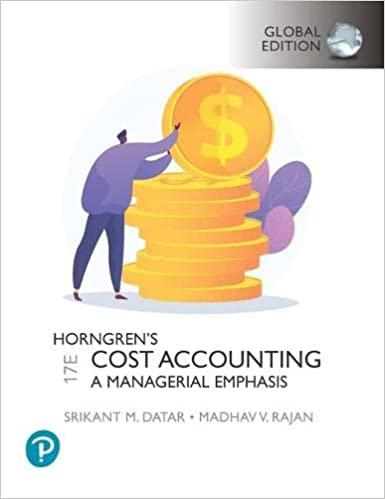Answered step by step
Verified Expert Solution
Question
1 Approved Answer
Please find all the required for this question and solve it in details TechnoSide, Inc., manufactures and sells a unique electronic part. Operating results for


Please find all the required for this question and solve it in details
TechnoSide, Inc., manufactures and sells a unique electronic part. Operating results for the first three years of activity were as follows (absorption costing basis): Sales dropped by 20% during Year 2 due to the entry of several foreign competitors into the market. TechnoSide had expected sales to remain constant at 100,000 units for the year; production was set at 100,000 units in order to build a buffer of protection against unexpected spurts in demand. By the start of Year 3, management could see that spurts in demand were unlikely and that the inventory was excessive. To work off the excessive inventories, TechnoSide cut back production during Year 3, as shown below: Additional information about the company follows: 1. The company's plant is highly automated. Variable manufacturing costs (direct materials, direct labor, and variable manufacturing overhead) total only $5 per unit, and fixed manufacturing overhead costs total $555,000 per year. 2. Fixed manufacturing overhead costs are applied to units of product on the basis of each year's production (units produced). That is, a new fixed overhead rate is computed each year. 3. Variable selling and administrative expenses are $3 per unit sold. Fixed selling and administrative expenses total $100,000 per year. TechnoSide's management can't understand why profits tripled during Year 2 when sales dropped by 20%, and why a loss was incurred during Year 3 when sales recovered to previous levels. 1. Compute the unit product cost in each year under: a) Absorption costing (Show how much of this cost is variable and how much is fixed) b) Variable costing 2. Prepare a contribution format variable costing income statement for each year. 3. Refer to the absorption costing income statements, reconcile the variable costing and absorption costing net operating incomes for each year. 4. Refer again to the absorption costing income statements, explain why net operating income was higher in Year 2 than it was in Year 1 under the absorption approach, in light of the fact that fewer units were sold in Year 2 than in Year 1. 5. Refer again to the absorption costing income statements, explain why the company suffered a loss in Year 3 but reported a profit in Year 1, although the same number of units was sold in each year. 6. Assume that the company must obtain additional financing. As a member of top management, which of the income statements above would you prefer to take with you to negotiate with the creditor? Why? Note: You can use Microsoft Excel software to prepare income statement and other calculations. TechnoSide, Inc., manufactures and sells a unique electronic part. Operating results for the first three years of activity were as follows (absorption costing basis): Sales dropped by 20% during Year 2 due to the entry of several foreign competitors into the market. TechnoSide had expected sales to remain constant at 100,000 units for the year; production was set at 100,000 units in order to build a buffer of protection against unexpected spurts in demand. By the start of Year 3, management could see that spurts in demand were unlikely and that the inventory was excessive. To work off the excessive inventories, TechnoSide cut back production during Year 3, as shown below: Additional information about the company follows: 1. The company's plant is highly automated. Variable manufacturing costs (direct materials, direct labor, and variable manufacturing overhead) total only $5 per unit, and fixed manufacturing overhead costs total $555,000 per year. 2. Fixed manufacturing overhead costs are applied to units of product on the basis of each year's production (units produced). That is, a new fixed overhead rate is computed each year. 3. Variable selling and administrative expenses are $3 per unit sold. Fixed selling and administrative expenses total $100,000 per year. TechnoSide's management can't understand why profits tripled during Year 2 when sales dropped by 20%, and why a loss was incurred during Year 3 when sales recovered to previous levels. 1. Compute the unit product cost in each year under: a) Absorption costing (Show how much of this cost is variable and how much is fixed) b) Variable costing 2. Prepare a contribution format variable costing income statement for each year. 3. Refer to the absorption costing income statements, reconcile the variable costing and absorption costing net operating incomes for each year. 4. Refer again to the absorption costing income statements, explain why net operating income was higher in Year 2 than it was in Year 1 under the absorption approach, in light of the fact that fewer units were sold in Year 2 than in Year 1. 5. Refer again to the absorption costing income statements, explain why the company suffered a loss in Year 3 but reported a profit in Year 1, although the same number of units was sold in each year. 6. Assume that the company must obtain additional financing. As a member of top management, which of the income statements above would you prefer to take with you to negotiate with the creditor? Why? Note: You can use Microsoft Excel software to prepare income statement and other calculationsStep by Step Solution
There are 3 Steps involved in it
Step: 1

Get Instant Access to Expert-Tailored Solutions
See step-by-step solutions with expert insights and AI powered tools for academic success
Step: 2

Step: 3

Ace Your Homework with AI
Get the answers you need in no time with our AI-driven, step-by-step assistance
Get Started


